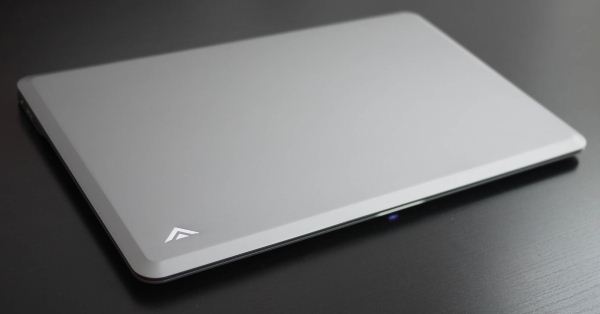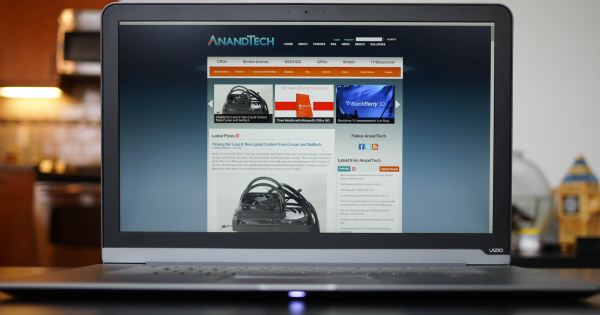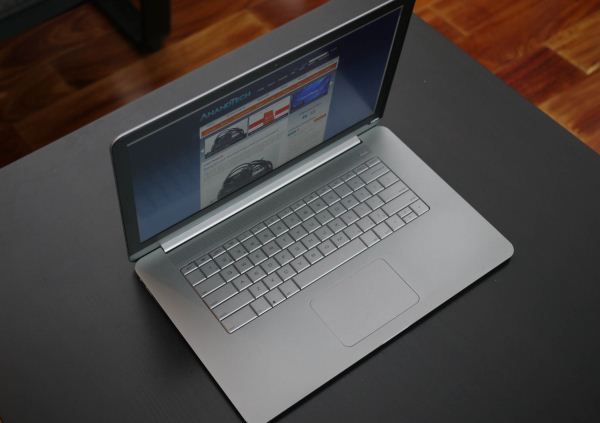Vizio Thin+Light CT15: Something New and Edgy
by Vivek Gowri on February 14, 2013 9:00 AM EST- Posted in
- Laptops
- Intel
- IPS
- Ivy Bridge
- Vizio
- Ultraportable
- Ultrabook
The Vizio is clean and sleek, really a notebook that looks like it was designed by actual industrial designers. This should be a pretty foregone conclusion, but there’s a large number of notebooks out there that don’t look like designers had any say in the designs, especially at the lower end.
The aesthetic is crisp and the entire notebook is very unadorned. There’s nothing glossy on this notebook—not the display, bezel, nor any of the aluminum or the soft touch plastic pieces that make up the chassis. It’s fantastic and I love it.
The body is a single piece of anodized aluminum with a gunmetal finish and the bottom half of the casing is soft-touch plastic. The lid is almost entirely clean, with a small Vizio logo in the top left corner. In profile, the notebook is mostly flat, with tapers at the front and side edges to enhance the perception of thinness. It’s a neat design trick, but I feel like it’s starting to be overused in the world of thin (and not so thin) notebooks. The sides have small portions that are flat, in order to house the meager assortment of ports. The flat part continues across the back of the notebook where the hinge is.
The bezel around the display is perfect—dark plastic with a matte finish, relatively thin, webcam and mics centered above the display, thin aluminum band at the bottom, and a very small Vizio logo at the bottom left corner. Whoever designed it could teach a course on notebook interior design that a lot of other notebook manufacturers could really benefit from.
I’m a fan of where Vizio has gone with their industrial design language, though there’s some refinement that remains on the build quality side of things—the anodization is noticeably coarser than what you find on recent Apple or ASUS devices, while the edges are sharper and more abrupt than they should be. I’ve seen variable build quality between units, with greater degrees of variance in the panel gaps and fit of the keyboard and touchpad. They’re glitches for sure, all signs that point to Vizio being very new to the PC hardware game still, but these are all relatively minor details that they should pick up on and fix as they move forward
Being only 0.68” thick and weighing less than 4 pounds, the CT15 is still slightly bulkier than the smaller and more svelte S9 15” (0.58”, 3.63lbs). Something about the ultrathin 15” form factor, like the Vizio and Samsung, as well as things like the Retina MacBook Pro 15” and the ASUS Zenbook U500, is very aesthetically appealing even though they lack the out-and-out portability of machines with smaller footprints. Even with the superlight weights in play here, the increased size makes this class of system more difficult to use in cramped spaces (such as a plane or lecture hall desk). But damn if they don’t look fantastic.
There’s one huge flaw in this entire design that I’ve been rhapsodizing about though. Surprisingly, it’s not the touchpad—the Sentelic pad that plagued the first run of Windows 7-based Vizio systems has been chucked in favor of a Synaptics unit that’s an absolute breath of fresh air in comparison. Nobody was lying to you, the Sentelic pad actually made the CT15 downright unusable, especially in comparison with the increasingly stellar Elan and Synaptics pads. Sure, they aren’t Apple, but they’re close. The Sentelic was closer to the dark ages for PC touchpads and the series of misguided buttonless pads used by HP and Dell. (Interestingly, my last experience with Sentelic was with the Dell Inspiron 11z from the CULV days. It had a similarly awful touchpad.) But that’s history, and thankfully we have Synaptics and their multitouch gesture suite.
No, the real issue here is the keyboard as well as the metal surrounding it. The keyboard was a problem spot before, too, and hasn’t been fixed. It’s one of the few notebooks that I’ve seen in the last four or five years without a chiclet style keyboard. Even the ThinkPad line, that bastion of old-school notebook design, has moved into the modern world, so it was a bit odd to see the older style of keyboard on this. But I have no quarrel with the keyboard style; the flatness seemed to go well with the rest of the industrial design. Unfortunately, there’s way too much flex involved, and not just in the keyboard itself. The interior aluminum flexes heavily as well, which is odd and indicates a very thin chassis material used. The display also exhibits a bit more flex than I would like, though it’s not a day to day issue like the keyboard and interior is. It’s pretty bad, and a major oversight for a company that seemed to be so detail oriented with the rest of the design.
The upcoming Thin+Light looks basically the same as the current one, but goes a long way towards fixing the interior flex. They made the interior aluminum panel a bit thicker, paired with a stiffer keyboard, and made all the build quality related issues go away. The typing experience is significantly better, though I still think they should move to a chiclet keyboard. You do get used to the flex in the current-gen CT15; it’s not a dealbreaker like the touchpad was previously, but it definitely does detract somewhat from the user experience.














55 Comments
View All Comments
MarcusMo - Friday, February 15, 2013 - link
Regarding the ports, these two statements are from your preview of the new Vizios at CES as well as the current review:"The selection of ports onboard is pretty disappointing as well"
"I think I’d still like to see some improvements in terms of ports on offer (2xUSB and no SD slot just isn’t enough)"
If you are going to tell someone to have reasonable expectations and "not to cry about ports", it is best not to have done it yourself several times first.
chrnochime - Thursday, February 14, 2013 - link
I don't see the link for the next CT15 announcement that's referred to in this article. Could someone post the link?Ninhalem - Thursday, February 14, 2013 - link
http://www.vizio.com/ces#!/thin-lightvectorm12 - Thursday, February 14, 2013 - link
I've been looking for a decent new laptop for a couple of months now. Thus far the closest I've come are some of the Sony Vaio computers. This version is a nogo for me as I imagine I couldn't live with the flex in the chassi. If some retailer in Sweden starts selling the revamp I'm gonna buy one. Too bad I can't find a single one in Sweden currently carrying Vizio. Here's hoping...kyuu - Thursday, February 14, 2013 - link
The upcoming revision sounds like a real winner if it really fixes the flex/keyboard issues and includes a bigger battery. Also being able to put an AMD A10 in there for some basic gaming on-the-go will be great. I'm just torn between getting this or their upcoming Tablet PC. Hopefully you guys will do a review of that in the near future.I don't really get the complaint about the ports (or lack thereof): I don't see me having a ton of things plugged into what's supposed to be a portable device. Also, while more RAM never hurts, 4GB is more than fine unless you're really going to be doing some serious work on it. Even then, dipping into the page file on an SSD isn't really a trying experience like it is with an HDD.
kyuu - Thursday, February 14, 2013 - link
Also, I have to echo another commenter: where are the temperature and noise sections of this review? I'd like to know if the thing gets hot enough to melt the enclosure to slag or turns into a jet engine under load.VivekGowri - Thursday, February 14, 2013 - link
Typically, I only include those sections on notebooks with GPUs in them. We're at a stage where mostly all systems (the ones without insane form factors at least) that rely on IVB for compute and graphics processing end up being completely fine from heat/noise standpoints unless something drastically goes wrong during the design phase. This is especially true when you have a 17W part in a 15" chassis.kyuu - Friday, February 15, 2013 - link
Fair enough. So I guess what you're saying is you experienced no noticeable noise or heat issues (including hot spots on the chassis) from the Vizio?jeffkro - Thursday, February 14, 2013 - link
Wow, that is so much better than my $300 Lenovo.Subyman - Friday, February 15, 2013 - link
Strange to see people defending Vizio for only offering 4GB of ram. I own a current MacBook Pro with 8GB of ram. I usually have PS CS6, Xcode, iOS simulator, a PDF reader, Safari, and a few miscellaneous development apps open. I easily hit the RAM limit at times, though most users would not multitask this much, I think Vizio is missing out on a robust business market.I'm looking for a Windows laptop for use with Office suite (Access, Excel, and Word) that will also be running proprietary billing software, a browser, and several smaller programs. This is a typical work setup that requires more than 4GB.
Lastly, buying a $1000 laptop isn't so you can scrape by now at the minimum specs, but so you don't have to purchase another device for 3-4 years. 4GB is the bare minimum these days, and it will quickly become useless.